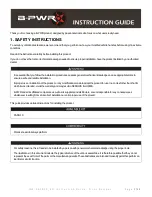
NVS 6
MANUAL
Page
36
7 OPERATION PROCEDURE
7.1 The conditions in which the night-vision goggles are operated
have their own idiosyncrasy, which requires certain skills on the part of
the pilot as the image of the terrain and objects visible through the night-
vision goggles is monochromic and not very soft.
7.2 The night-vision goggles enable the pilot not only to nap off the
earth but also view the instrument panel by taking a look downwards or
sideways past the eyepieces.
CAUTION:
WHEN THE NVS 6 IS USED AT NIGHT TIME, THE
SAFETY CAPS SHALL BE REMOVED FROM THE LENSES.
7.3 For removing the safety caps, press simultaneously on both
retainers and, while holding them depressed, take the cap off of the lens
mount. Put the removed caps into the case pocket.
7.4 After removing the safety caps, focus the lenses of each
monocular by rotating the lens about its optical axis so as to attain the
sharp image of the viewed objects in the space outside the cockpit (for
convenience of rotation each lens is provided with knurling).
7.5 In case that the airborne power supply is not available, turn on
the independent power source to feed power to the night-vision goggles
by turning cap (6) of cap-switch (5) (Ref. Fig. 6.4).
7.6 If the night-vision goggles become exposed to bright light, turn
your head to divert the lenses sideways so as to bring the image of bright
light sources outside the field of view.
7.7 In the event of fogging of the eyepieces of the night-vision
goggles (low temperature), pull the goggles out of the operating position
and wipe dry the external surfaces of the eyepieces with a cloth included
in the single set of spare parts.
7.8 After long usage of the night-vision goggles on the pilot’s head
(more than 2.5 h), the pilot may feel a light fatigue in the neck muscles.
Summary of Contents for NVS 6
Page 59: ...NVS 6 MANUAL Page 54 ...















































